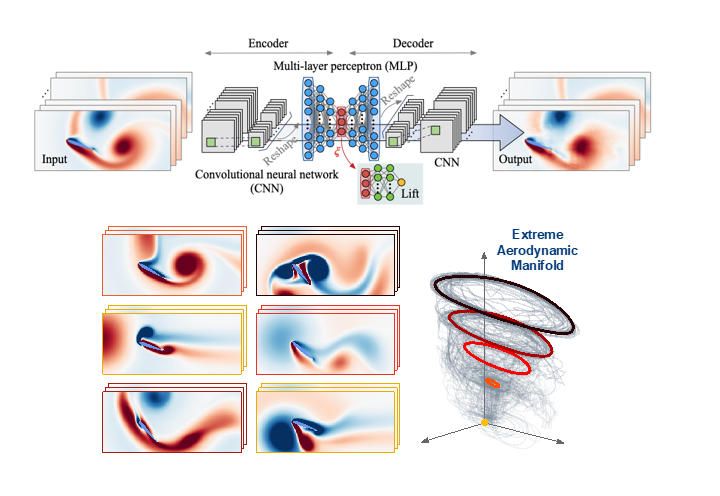UCLA MAE Ph.D. student Kai Fukami and his supervisor Professor Kunihiko Taira have recently discovered a low-dimensional manifold that captures the dynamics behind a wide range of extreme aerodynamic scenarios with spatiotemporal high degrees of freedom by leveraging machine learning and computational fluid dynamics. They particularly consider “extreme aerodynamics” — aerodynamics associated with flying in severe atmospheric turbulent conditions that small-scale modern aircraft such as drones would encounter in urban canyons and over mountainous areas. Such extremely adverse weather conditions are traditionally avoided by air vehicles. Their discovery with significant data compression can support stable flight of next-generation aircraft in extremely violent air space along with their previously-developed technology using machine learning that provides state awareness (https://www.mae.ucla.edu/kai-fukami-and-kunihiko-taira-develop-breakthrough-machine-learning-technique-which-reconstructs-physics-from-a-limited-number-of-sensor-measurements/#).
This breakthrough was published in Nature Communications on 10/14/2023 entitled “Grasping extreme aerodynamics on a low-dimensional manifold.” (https://www.nature.com/articles/s41467-023-42213-6)
This study was supported by a 2022 Vannevar Bush Faculty Fellowship from the U.S. Department of Defense (DoD), the most prestigious research grant for which Professor Kunihiko Taira was selected in the 2022 class (https://www.mae.ucla.edu/ucla-engineer-sam-taira-receives-department-of-defenses-most-prestigious-research-grant-vannevar-bush-faculty-fellowship/).
Abstract (from Fukami & Taira, Nature Communications 2023)
Modern air vehicles perform a wide range of operations, including transportation, defense, surveillance, and rescue. These aircraft can fly in calm conditions but avoid operations in gusty environments, encountered in urban canyons, over mountainous terrains, and in ship wakes. With extreme weather becoming ever more frequent due to global warming, it is anticipated that aircraft, especially those that are smaller in size, will encounter sizeable atmospheric disturbances and still be expected to achieve stable flight. However, there exists virtually no theoretical fluid-dynamic foundation to describe the influence of extreme vortical gusts on wings. To compound this difficulty, there is a large parameter space for gust-wing interactions. While such interactions are seemingly complex and different for each combination of gust parameters, we show that the fundamental physics behind extreme aerodynamics is far simpler and lower-rank than traditionally expected. We reveal that the nonlinear vortical flow field over time and parameter space can be compressed to only three variables with a lift-augmented autoencoder while holding the essence of the original high-dimensional physics. Extreme aerodynamic flows can be compressed through machine learning into a low-dimensional manifold, which can enable real-time sparse reconstruction, dynamical modeling, and control of extremely unsteady gusty flows. The present findings offer support for the stable flight of next-generation small air vehicles in atmosphere conditions traditionally considered unflyable.

